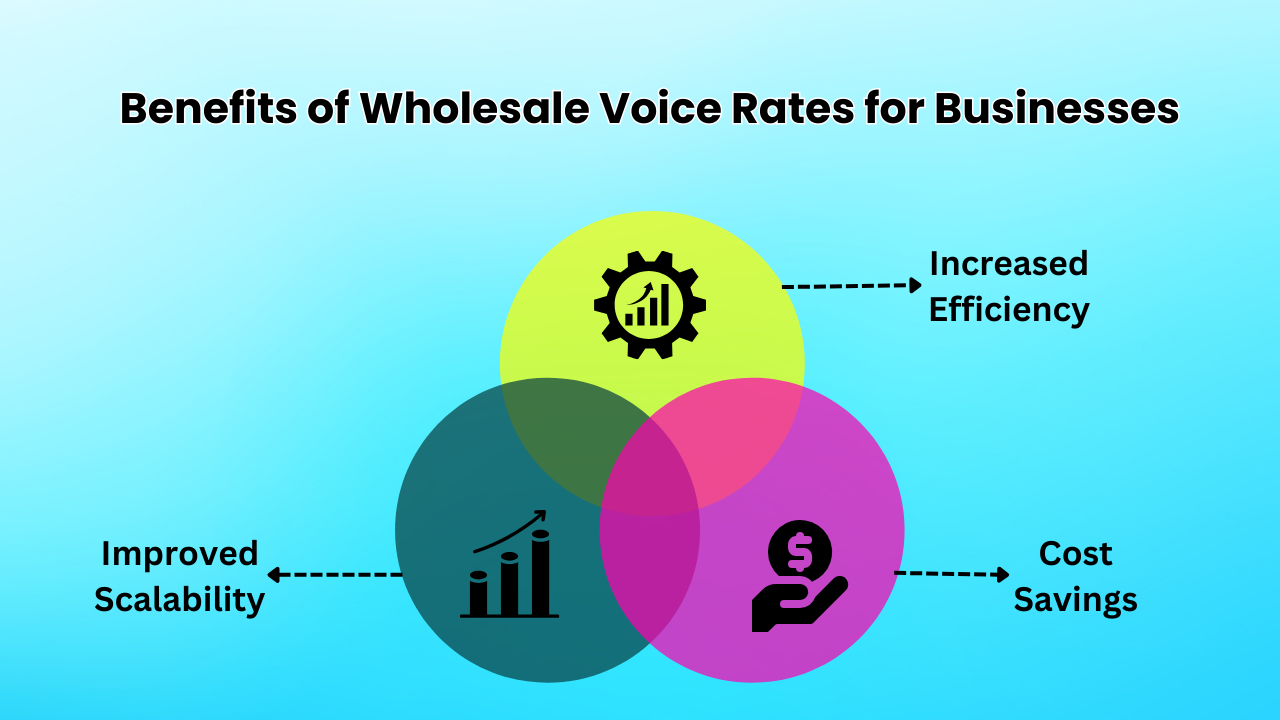Introduction
In the rapidly evolving telecommunications industry, understanding wholesale voice rates is crucial for businesses and organizations that rely on voice services. Wholesale voice rates refer to the prices charged by telecommunications companies for bulk voice minutes, and they play a significant role in determining the cost of voice services for businesses. As telecommunications technology advances and competition increases, businesses need to be well-informed about these rates to make strategic decisions that affect their operational costs and efficiency.
Bulk voice minute pricing refers to the costs associated with large-scale voice services, typically offered by telecommunications companies to other businesses, carriers, and organizations. These pricing models are designed for high-volume voice traffic and aim to provide cost savings and increased efficiency for businesses requiring extensive voice services. By purchasing voice minutes in bulk, businesses can benefit from reduced per-minute costs compared to retail rates, making bulk voice minute pricing a crucial factor in managing and optimizing communication expenses.
Key Takeaways
- Cost Savings: Understanding bulk voice minute pricing can lead to significant cost reductions by allowing businesses to purchase voice minutes in bulk at lower per-minute rates compared to retail prices.
- Informed Negotiations: With a solid understanding of voice minute pricing structures, businesses can negotiate more favorable terms with telecommunications providers, potentially securing better rates and services.
- Optimized Efficiency: Knowing how bulk voice minute pricing works enables businesses to better manage and optimize their communication expenses, improving overall operational efficiency.
- Market Competitiveness: Staying informed about voice market dynamics and industry trends helps businesses remain competitive by leveraging cost-effective voice solutions and adapting to market changes.
- Strategic Planning: Businesses can make more strategic decisions regarding their voice services by understanding the factors influencing voice minute pricing and how they impact their overall communication strategy.
What are Wholesale Voice Rates?

Wholesale voice rates are the prices charged by telecommunications companies for bulk voice minutes. These rates are specifically designed for businesses, carriers, and organizations that need large volumes of voice traffic. Voice minute pricing plans are typically structured in various formats to accommodate different communication needs. For instance, inbound voice minute rates pertain to the cost of receiving incoming voice calls, while outbound voice minute rates cover the expense of making outgoing voice calls. Additionally, international voice termination rates apply to voice calls made between different countries, offering a pricing structure for global communications.
Types of Wholesale Voice Rates
Wholesale voice rates can be categorized into several types, each serving a different purpose within telecommunications networks. Termination rates refer to the prices charged for completing voice calls on a network, effectively handling the end of the call. Origination rates, on the other hand, are associated with the initiation of voice calls on a network. Transit rates involve the costs of transporting voice calls between different telecommunications networks, facilitating communication across various providers. Each type of rate plays a crucial role in managing and optimizing voice traffic within and between networks.
- Termination Rates: Prices charged for terminating voice calls on a telecommunications network.
- Origination Rates: Prices charged for originating voice calls on a telecommunications network.
Benefits of Wholesale Voice Rates
Bulk voice minute plans offer several significant benefits to businesses and organizations. One of the primary advantages is cost savings; by purchasing voice minutes in bulk, businesses can achieve substantial reductions in their communication expenses compared to standard retail rates. Additionally, bulk voice solutions contribute to increased efficiency by allowing businesses to streamline their voice services and optimize their operations. Another key benefit is scalability; bulk voice minute plans provide the flexibility needed to expand and adjust voice services in response to growing demands, ensuring that businesses can adapt to changes in their communication needs effectively.
- Cost Savings: Wholesale voice rates can provide significant cost savings compared to retail voice rates.
- Increased Efficiency: Wholesale voice rates can help businesses optimize their voice services for increased efficiency.
How are Wholesale Voice Rates Determined?

The pricing of voice services is determined by a combination of factors that reflect the complexities of operating and maintaining telecommunications networks. Network costs are a primary consideration, encompassing the expenses associated with maintaining and running the infrastructure necessary for voice services. Traffic volume also plays a crucial role; higher volumes of voice traffic can lead to more competitive pricing, whereas lower volumes might result in higher rates. Competition within the market influences pricing as well, with increased competition often driving rates down. Additionally, regulatory requirements must be factored in, as compliance with various standards and regulations can affect pricing structures. Finally, global events such as natural disasters or economic downturns can impact voice service pricing by disrupting supply or altering demand, leading to fluctuations in pricing.
Role of Regulatory Requirements
Regulatory requirements significantly influence the determination of voice service pricing. Telecommunications companies are required to adhere to standards related to the quality of service, ensuring that voice services meet certain performance benchmarks. Interoperability regulations mandate that different telecommunications networks are able to interconnect and exchange voice traffic seamlessly, affecting how pricing structures are designed. Additionally, number portability regulations allow customers to retain their phone numbers when switching between providers, which can also impact pricing. Compliance with these regulations ensures that voice services remain reliable and accessible, but also introduces additional considerations in rate determination.
Impact of Global Events
Global events can have a notable impact on voice service pricing by affecting both demand and supply. For example, natural disasters can lead to an increased demand for voice services as businesses and individuals seek reliable communication channels, which can drive up prices for voice minutes. Conversely, economic downturns or other global disruptions can affect the supply of voice services, either by causing operational challenges or by altering market dynamics, potentially leading to higher costs for telecommunications providers, which may then adjust their pricing structures accordingly. These events create fluctuations in the telecommunications market, influencing how providers set and adjust their rates in response to changing conditions.
Factors Affecting Wholesale Voice Rates

Several factors can influence the costs of bulk voice services, shaping the pricing landscape for businesses. Technological advancements are a major factor; as technology evolves, it often leads to reductions in costs and improvements in efficiency, which can result in lower prices for voice minutes. Changes in demand also play a critical role; fluctuations in the need for voice services can cause pricing to rise or fall accordingly. Market trends, such as the increasing adoption of VoIP (Voice over Internet Protocol) technology, can impact both the pricing and quality of voice services. Additionally, the level of competition in the market can drive prices up or down, depending on how competitive the landscape is. Regulatory changes, including updates to industry standards and requirements, can also affect the pricing of voice services by introducing new compliance costs or altering market dynamics.
Technological Advancements
Technological advancements, particularly the adoption of VoIP technology, have a profound impact on the voice services market. As new technologies emerge, they often reduce the costs associated with providing voice services by utilizing more efficient and cost-effective methods. These advancements also improve the overall efficiency of voice services, leading to streamlined operations and enhanced performance. Furthermore, technological innovations can increase the quality of voice services, offering clearer and more reliable communications. As a result, these advancements contribute to lower pricing for bulk voice minutes by driving down operational expenses and enhancing service capabilities.
Changes in Demand
Changes in demand for voice services can significantly impact the pricing of bulk voice minutes. When demand for voice services is high, providers tend to increase their prices as they adjust their pricing to match the higher demand. Conversely, if demand decreases, prices may drop as providers seek to attract more customers or manage excess capacity. This dynamic means that the cost of voice services is closely tied to fluctuations in market demand, with providers adjusting their pricing to reflect changes in service requirements and usage patterns.
Market Trends
Market trends, including the shift toward VoIP technology, have a notable impact on the pricing and quality of bulk voice services. The growing adoption of VoIP has influenced pricing by offering more cost-effective and scalable solutions compared to traditional voice services. This shift in technology can also affect the quality of voice services, as VoIP often provides higher-quality communications with advanced features. As market trends evolve, they reshape the landscape of voice services, leading to adjustments in pricing and service quality to align with current technological and consumer preferences.
Wholesale Voice Rates in the Telecommunications Industry

Wholesale voice rates are a fundamental component of the telecommunications industry, serving multiple critical functions. These rates enable communication between different telecommunications networks by establishing the cost structure for exchanging voice traffic. They also facilitate competition among telecommunications companies by providing a framework for pricing and service agreements that can influence market dynamics. Additionally, the pricing of bulk voice minutes significantly impacts the revenue of telecommunications companies, as these prices contribute to the overall financial performance of service providers based on the volume of voice traffic they handle.
Role of Wholesale Voice Rates in Telecommunications
Wholesale voice rates are essential for telecommunications companies as they underpin several key operational aspects. They allow interconnection between different telecommunications networks, making it possible for calls to be routed across various providers. This interconnection is vital for maintaining a seamless communication experience for users. The pricing of bulk voice minutes also enables roaming services for mobile customers, allowing them to use their phones in different regions or countries while maintaining connectivity. Furthermore, these prices facilitate the provision of voice services to customers, ensuring that telecommunications companies can offer comprehensive and competitive communication solutions.
- Allow Interconnection: Allow interconnection between different telecommunications networks.
- Enable Roaming: Enable roaming services for mobile customers.
Impact of Wholesale Voice Rates on Telecommunications Companies
Bulk voice minute pricing can have a profound impact on telecommunications companies. These pricing models directly affect the revenue of providers, as they determine the income received from bulk voice traffic. They also influence the pricing of voice services offered to customers, with bulk voice pricing potentially affecting the final retail prices. Additionally, bulk voice minute pricing can impact the profitability of telecommunications companies by influencing their cost structures and financial margins. Providers must carefully manage these pricing models to balance competitiveness, service quality, and profitability.
- Affect Revenue: Affect the revenue of telecommunications companies.
- Influence Pricing: Influence the pricing of voice services for customers.
Challenges and Opportunities
The telecommunications industry faces several challenges and opportunities related to wholesale voice rates. Regulatory challenges include ensuring compliance with various regulations that govern service quality, interoperability, and pricing. These regulations can be complex and require ongoing adjustments to remain compliant. On the other hand, technological opportunities present significant potential for advancement. For example, the adoption of VoIP technology offers a chance to reduce costs, improve service efficiency, and enhance voice quality, leading to new business opportunities and competitive advantages in the market.
- Regulatory Challenges: Regulatory challenges, such as ensuring compliance with regulatory requirements.
- Technological Opportunities: Technological opportunities, such as the adoption of VoIP technology.
Benefits of Wholesale Voice Rates for Businesses

Bulk voice minute pricing offers a range of benefits for businesses, significantly enhancing their communication capabilities and financial efficiency. One of the primary advantages is cost savings; by purchasing voice minutes in bulk, businesses can achieve substantial reductions in their communication expenses compared to retail rates. These savings are often supplemented by discounts negotiated for large volumes of voice traffic. Additionally, optimized voice service pricing can improve operational efficiency by streamlining communication processes and allowing for better resource utilization. Businesses also benefit from improved scalability, as flexible voice service plans provide the ability to adjust and expand voice services in response to growing demands.
Cost Savings
Wholesale voice rates are instrumental in helping businesses save on communication costs in several key ways. Typically, bulk voice minute pricing is lower than retail rates, providing immediate savings on voice services. Businesses can further benefit from negotiating discounts for purchasing larger volumes of voice traffic, which can lead to even greater reductions in overall expenses. Additionally, the efficient use of resources facilitated by optimized voice service plans allows businesses to streamline their communication infrastructure and reduce unnecessary expenditures. This combination of reduced rates, discounts, and resource optimization translates into significant cost savings for businesses.
Increased Efficiency
Optimized voice service pricing contributes to increased efficiency within businesses by streamlining communication processes and automating various functions. By leveraging bulk voice minute pricing, businesses can enhance communication between different departments and locations, leading to more effective and coordinated operations. Additionally, efficient voice service plans enable automation of processes such as call routing and billing, reducing the need for manual intervention and minimizing administrative overhead. This streamlined approach not only improves operational efficiency but also ensures that communication systems run smoothly and effectively.
Improved Scalability
Wholesale voice rates facilitate the scalability of voice services, allowing businesses to adapt to changing needs and growing demands. By increasing the capacity of voice services through bulk purchasing, businesses can handle higher volumes of communication without facing capacity constraints. Additionally, the flexible pricing plans associated with wholesale voice rates provide businesses with the ability to scale their services in a cost-effective manner. This flexibility ensures that businesses can expand their communication capabilities as needed while managing their budgets effectively.
Challenges and Limitations of Wholesale Voice Rates

While bulk voice pricing models offer several advantages, they also come with a set of challenges and limitations that businesses must consider. One significant concern is the quality of service; to reduce costs, some bulk voice solutions may compromise on service quality, potentially leading to issues such as poor call clarity and dropped calls. Additionally, interoperability issues can arise between different networks, which might result in connectivity problems and the complexities associated with incompatible systems. Security risks are another important factor; without proper safeguards, bulk voice services can increase the potential for unauthorized access and data theft, posing threats to both financial security and business reputation.
Quality of Service
Pursuing cost-effective voice solutions can sometimes lead to a compromise in the quality of service to achieve cost reductions. This trade-off can result in several issues, such as poor call quality, which negatively impacts business operations and communication effectiveness. Additionally, the potential for dropped calls increases, leading to disruptions in communication that can affect productivity and revenue. Businesses must carefully assess these potential quality concerns when considering bulk voice pricing options, ensuring that the cost benefits do not outweigh the operational challenges associated with reduced service quality.
- Poor Call Quality: Poor call quality can negatively impact business operations.
- Dropped Calls: Dropped calls can lead to lost productivity and revenue.
Interoperability Issues
Interoperability issues are a notable challenge associated with wholesale voice rates. These problems can occur when different networks or systems are unable to seamlessly connect and exchange voice traffic. Such connectivity issues can disrupt business operations, causing delays and interruptions in communication. Additionally, incompatible systems may lead to increased costs and complexity as businesses attempt to integrate or reconcile disparate technologies. Addressing interoperability challenges requires careful planning and coordination to ensure smooth and effective communication across various networks.
- Connectivity Problems: Connectivity problems can disrupt business operations.
- Incompatible Systems: Incompatible systems can lead to additional costs and complexity.
Security Risks
The use of wholesale voice rates can introduce security risks if adequate protective measures are not implemented. One major concern is unauthorized access, which can lead to security breaches and potential misuse of voice services. Additionally, the risk of data theft is significant; if sensitive information is not properly secured, it can result in financial losses and damage to the business’s reputation. It is crucial for businesses to implement robust security protocols and continuously monitor their communication systems to mitigate these risks and safeguard their voice services against potential threats.
- Unauthorized Access: Unauthorized access to voice services can lead to security breaches.
- Data Theft: Data theft can lead to financial losses and reputational damage.
Future of Wholesale Voice Rates

The future of wholesale voice rates will be influenced by a range of evolving factors. Technological advancements, such as the continued development and deployment of VoIP and 5G technologies, are expected to significantly impact wholesale voice rates by potentially lowering costs and enhancing service capabilities. Increasing demand for voice services, driven by trends like remote work and digital transformation, will also play a crucial role in shaping future rates. As businesses and individuals rely more on voice communications, the dynamics of pricing and service offerings will evolve accordingly.
Trends and Predictions
Several trends and predictions suggest a transformative future for the voice services market. The increased adoption of VoIP technology is likely to lead to lower pricing for bulk voice minutes, as VoIP offers a more cost-effective and efficient means of providing voice services compared to traditional methods. Concurrently, the growing demand for high-quality voice services will drive increased investment in network infrastructure to support enhanced performance and reliability. There will also be a heightened focus on security, prompting greater investment in security measures to protect against threats and ensure the integrity of voice communications. Moreover, the emergence of more flexible pricing models is expected, as providers adapt to the changing needs of businesses and offer tailored solutions to accommodate diverse requirements.
Opportunities and Challenges
The future landscape of bulk voice services presents both opportunities and challenges. On the one hand, there are significant opportunities for cost savings through enhanced efficiency and automation. Advances in technology and improved operational practices can reduce costs and streamline processes, benefiting businesses that leverage bulk voice solutions. On the other hand, businesses will face challenges related to regulatory compliance, as evolving regulations will require ongoing adjustments to ensure adherence to new standards. Additionally, maintaining high levels of security and service quality will be crucial as the industry adapts to new technologies and increasing demands. Balancing these opportunities and challenges will be key to navigating the future of voice services effectively.
Conclusion
In conclusion, wholesale voice rates are a fundamental aspect of the telecommunications industry, playing a vital role in enabling communication between different networks and fostering competition among providers. For businesses and organizations that rely on voice services, understanding these rates is crucial for making informed decisions and optimizing their communication strategies. Bulk voice minute pricing, which refers to the costs associated with large-scale voice services, is influenced by various factors such as network costs, traffic volume, and market competition. While these pricing models offer significant benefits, including cost savings, increased efficiency, and enhanced scalability, they also come with challenges and limitations. Issues such as compromised quality of service, interoperability problems, and security risks must be carefully managed to ensure effective and reliable communication. By comprehensively understanding the complexities of bulk voice minute pricing and their implications, businesses can better navigate the telecommunications landscape and leverage these pricing models to their advantage.
FAQ'S
Wholesale voice rates are the prices charged by telecommunications companies for bulk voice minutes, typically offered to businesses, carriers, and organizations that need large volumes of voice traffic. These rates are lower than retail rates, providing cost savings for high-capacity voice services.
Businesses benefit from wholesale voice rates by achieving significant cost savings, optimizing communication efficiency, and enabling scalability. Bulk purchasing allows for lower per-minute costs, making it easier to manage and reduce communication expenses.
Wholesale voice rates are influenced by factors such as network costs, traffic volume, market competition, regulatory requirements, and global events. These elements impact the pricing structure and can cause rates to fluctuate over time.
Challenges include potential compromises in service quality, interoperability issues between different networks, and security risks. Businesses need to carefully manage these aspects to ensure reliable and secure communication.
The future of wholesale voice rates will likely be shaped by technological advancements, increasing demand for voice services, and the need for enhanced security. Trends such as the adoption of VoIP and 5G technologies are expected to lower costs and improve service capabilities.





